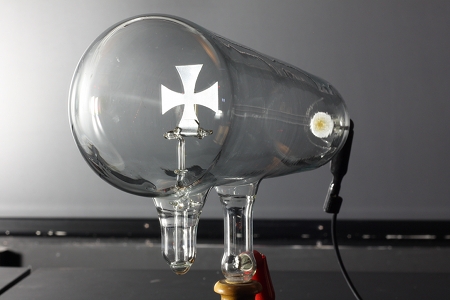Maltese cross obstacle and fluorescing glass show that electrons in a Crookes tube travel in straight lines and are affected by magnetic fields.


What it shows:
Cathode rays in a Crookes tube are seen to travel in straight lines by casting a sharp shadow of a Maltese cross on fluorescing glass. They can also be deflected by magnetic fields, as seen by the distortion of the shadow. Ionization in the base (between the anode and main part of the tube) gives a faint purple glow. When the cross is in the "down" position 1 the previously shadowed region of the glass glows brighter, giving a "positive" image of the cross.
How it works:
Electrons accelerated from the cathode at the rear of the tube are carried by their momentum to the front wall, where they strike the glass and cause it to fluoresce. However, those electrons on a collision course with the cross never reach the glass, leaving a dark shadow in the green fluorescence. The effect of a magnetic field on the moving electrons can be shown by bringing a magnet close to the tube, thus distorting the image of the cross.
Setting it up:
Please use gloves and safety glasses when handling this fragile vacuum tube. Avoid prolonged exposure to X-rays. The Maltese Cross tube uses a 6V DC supply and induction coil. 2 Connect the negative-voltage output of the coil to the cathode at the rear of the tube; the positive output connects to the anode at the base of the tube. A small Alnico bar magnet is sufficient to deflect the beam.
Comments:
On some Maltese cross CRTs, the metal cross itself acts as the anode. The effect of the electrons being decelerated by the glass are shown in Bremsstrahlung.
1 The metal cross is hinged so it can swivel up and down by gently tilting the entire tube.
2 Ours are CENCO, similar to the Sargent-Welch 2392A model.